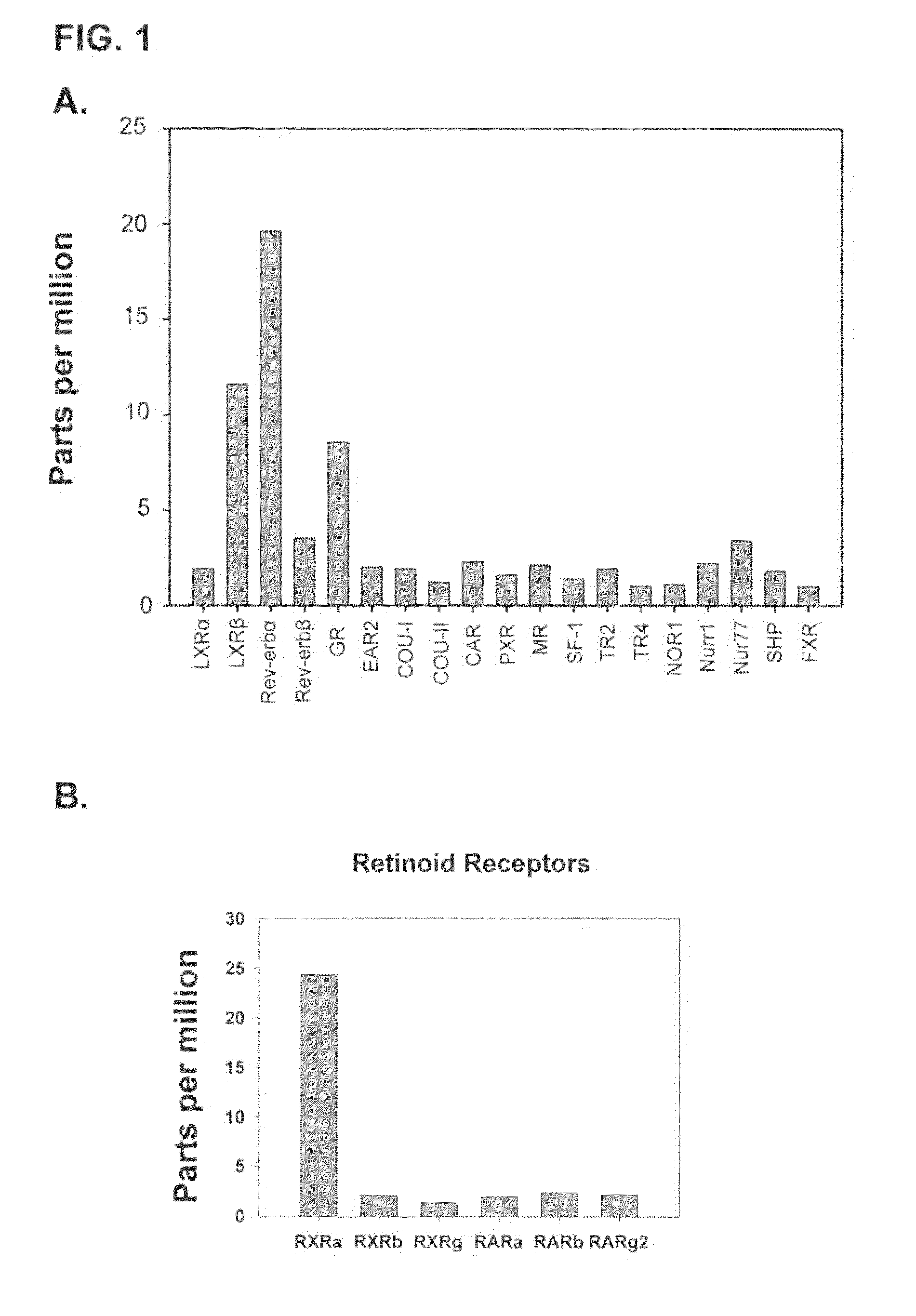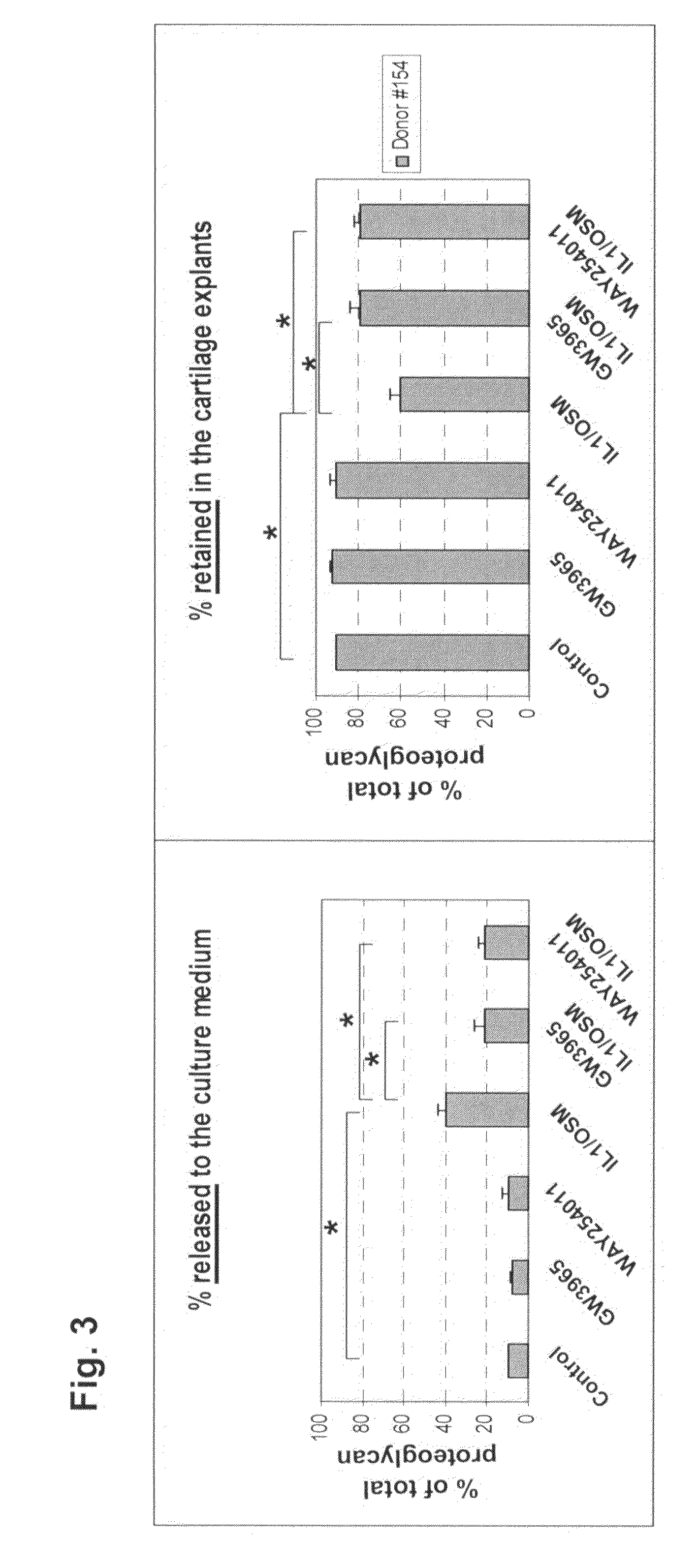Use of LXR agonists for the treatment of osteoarthritis
- Summary
- Abstract
- Description
- Claims
- Application Information
AI Technical Summary
Benefits of technology
Problems solved by technology
Method used
Image
Examples
example 1
[0067]To identify transcripts expressed in either arthritic or normal articular cartilage, tissue samples were obtained from arthritis patients with end-stage knee replacement and nonarthritic amputee individuals. The presence or absence of arthritis was confirmed by histology.
[0068]The Human Genome U95Av2 (HG-U95Av2) GeneChip® Array (Affymetrix, Santa Clara, Calif.) was used for expression profiling. The HG-U95Av2 chip contains 25-mer oligonucleotide probes representing ˜12,000 primarily full-length sequences (˜16 probe pairs / sequence) derived from the human genome. For each probe designed to be perfectly complimentary to a target sequence, a partner probe is generated that is identical except for a single base mismatch in its center. These probe pairs allow for signal quantitation and subtraction of nonspecific noise.
[0069]RNA was extracted from individual articular cartilage tissue, converted to biotinylated cRNA, and fragmented according to the Affymetrix protocol. The fragmente...
example 2
[0072]FIG. 2A shows the comparison of ApoD mRNA levels in normal cartilage and cartilage obtained from medium and severe osteoarthritic patients (expressed as parts per million (ppm)). The lower quantitative limit of detection for these gene chips studies was determined to be approximately 5 ppm. The data shown in FIG. 2A provides evidence that the expression of ApoD message is dramatically reduced in mild and severe osteoarthritic cartilage when compared to the normal cartilage. FIG. 2B shows the comparison of TNFα mRNA levels in normal cartilage and cartilage obtained from medium and severe osteoarthritic patients (expressed as parts per million (ppm)). The lower quantitative limit of detection for these gene chips studies was determined to be approximately 5 ppm. The data shown in FIG. 2B provides evidence that the expression of TNFα is significantly induced in mild and severe osteoarthritic cartilage when compared to the normal cartilage.
example 3
[0073]Fresh cartilage explants (˜20 pieces, a total of ˜200 mg / well) from a human OA donor (#154, from National Disease Research Interchange) were cultured for 10 days in 1 ml of DMEM / F12 containing 1% Nutridoma® (Roche Applied Science, Indianapolis, Ind.). During the 10 days, the explants were exposed to cytokines (1 ng / ml IL1β plus 5 ng / ml Oncostatin M) with or without LXR agonists (2 μM GW3965, a reported LXR agonist, or 2 μM of [4-({3-[3-benzyl-8-(trifluoromethyl)quinolin-4-yl]phenoxy}methyl)phenyl]acetic acid (Formula I shown below), an LXR agonist).
Every 2 days the culture medium was replaced with fresh cytokines and LXR agonists. Accumulative release of proteoglycans was measured in these cultures after using DMMB (dimethylmethylene blue) assay. The explants at the end of the 10-day treatment were then digested with proteinase K and assayed for total proteoglycan content. LXR agonists significantly reduced cytokine-induced release of proteoglycan into the culture medium; cons...
PUM
| Property | Measurement | Unit |
|---|---|---|
| Responsivity | aaaaa | aaaaa |
| Level | aaaaa | aaaaa |
| Degradation properties | aaaaa | aaaaa |
Abstract
Description
Claims
Application Information
 Login to View More
Login to View More - R&D
- Intellectual Property
- Life Sciences
- Materials
- Tech Scout
- Unparalleled Data Quality
- Higher Quality Content
- 60% Fewer Hallucinations
Browse by: Latest US Patents, China's latest patents, Technical Efficacy Thesaurus, Application Domain, Technology Topic, Popular Technical Reports.
© 2025 PatSnap. All rights reserved.Legal|Privacy policy|Modern Slavery Act Transparency Statement|Sitemap|About US| Contact US: help@patsnap.com



